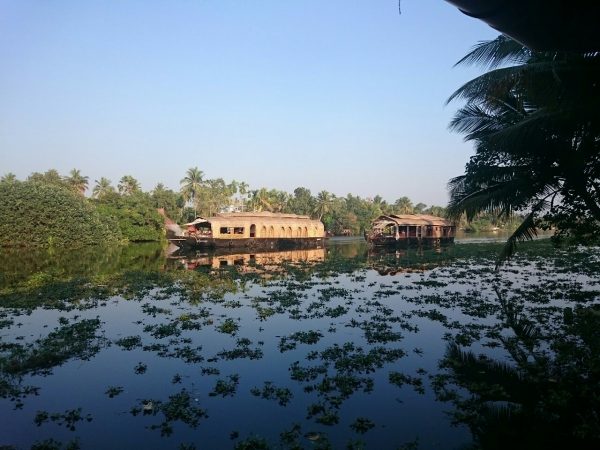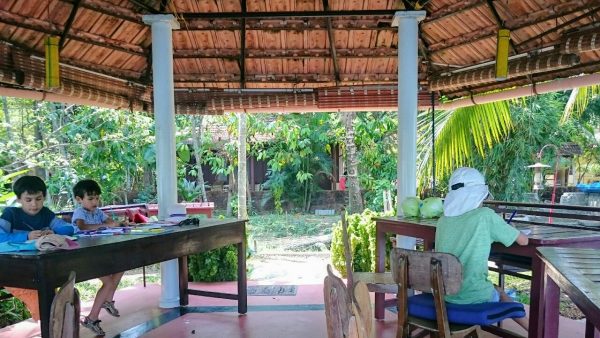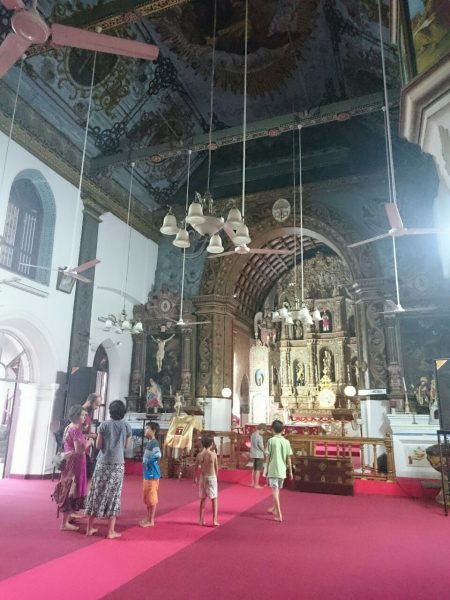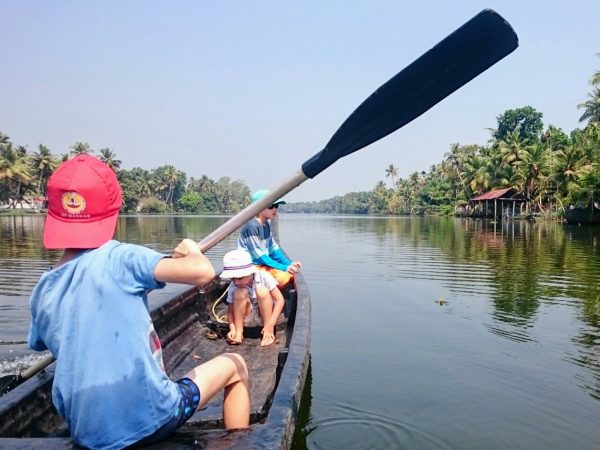Between the mountains and the coast stretching along the middle third of the Keralan state (and maybe more) lie The Backwaters. This wetland area, cunningly created from who knows what and how long ago, is creatively named by the tourist marketing board to be reminiscent of a mosquito manufactory but is in fact a languid lakeland. An almost-grid of canals criss-cross between lakes and towns divvying up the land into marshy rice paddies and plantations of all sorts of tasty fruits and spices.

Houseboats modelled on traditional rice boats. Others appear to be constructed from blue tarps.
It is popular among visitors to hire a houseboat and pootle around these backwaters but we did not do so as we are naturally contrary. It can also be said that it was incompatible with our budget,that the boys would go mad (and by extension their parents too) if confined to such a limited space, and also that the boats are a major source of pollution which is the last thing this place needs. Instead we opted for a homestay on the banks of one of the canals from where we could see houseboats chugging back and forth as often as we pleased and often more so.
We were reluctant to leave the beaches but, in the end, washing up at Kaits Homestay proved to an opportunity for a calm local stop that was exactly what was called for. Jossy and family run a small farm and they both filled us with insight on the local plants and life and filled us with all sorts of deliciousness derived from these plants and knowledge. Between bouts of passionfruit juice and coconut curry, fresh rotis and sweet fruits we were forced into an indolent and perhaps Keralan lifestyle.
Perhaps the best feature of the homestay was that we rocked up to find another Anglo-French family freshly installed with 3 kids in tow. The boys instantly bonded doing whatever boys do and were thereafter hardly seen. We ended up spending pretty much the whole time with the two families together: eating, outing, schooling and laying about.

Canal schooling. Large classes.
In the area we did not venture far for there was no need and little desire. To be able to explore the immediate surrounds without the need for motor vehicles makes it an intimate and deeper experience. We strolled along the canal path to the local village, visited the local church and took the kayaks and canoes out for a paddle up and down the canal, dodging houseboats and “rafting up” to ride out any wake from the local ferries. A call for biscuits was enough to get everyone into the boats and down to the village. All along the way local kids would rush to the waterside to wave and hello.
At the village, despite no less than ten separate warnings from no less than ten different locals to beware the slipperiness of the lowest step when disembarking our embarking the kayak, at least two of our number managed spectacular pratfalls at the dock. I was fortunate that my effort attracted a sizeable crowd who were greatly entertained, having coincided perfectly with a congregation of 8 houseboats who had all moored at the same time in order to visit the church.

The church at Champakulam is a famous stop in the backwaters but was basically on our doorstep, next to the snack shop. It is rococo in style but with added ceiling fans.
The church is an interesting one. It is remarkable the number of churches in this post of the country – it has a strong Christian heritage that is much more obvious than elsewhere. This church (of St Thomas in Champakulam) was founded almost 1500 years ago. Of course because they are building on what is basically a bog, the original fell into the swamp. The second burned down and fell into the swamp. The third… etc. The current model is almost 300 years old – when it was built it had 13 or 14 steps leading up to it. Now it is level with the ground. Soon it will have steps leading down to it and shortly after that you can probably guess the likely result.
The waters themselves are wide and flat calm. I don’t think that there is any current. Paddling is a breeze in a kayak, sluggardly in the traditional canoe and tortuous in a rowboat. The locals have long tail boats and no problem moving tonnes of stones back and forth.

Traditional canoe shaped canoe glides effortlessly along the backwaters. Well, effortless at least for those not laden with a paddle.

<3<3<3<3<3